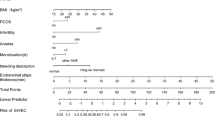Abstract
Purpose
To evaluate the role of body mass index (BMI) in women with premenopausal heavy menstrual bleeding (HMB) to identify patients who should undergo endometrial biopsy.
Methods
This prospective cohort study included 1120 premenopausal women who presented to the Gynecology Clinic, Bakirkoy Dr. Sadi Konuk Training and Research Hospital in Istanbul, Turkey, due to HMB and who underwent endometrial sampling. The abnormal endometrial histopathological results were analyzed by separating patients into groups of all abnormal findings (hyperplasia without atypia + hyperplasia with atypia + carcinoma) and hyperplasia with atypia + carcinoma. Sensitivity and specificity of the abnormal histopathological results were calculated in both groups using BMI cut-off values as 25, 30 and 35 and age cut-offs as 40 and 45 years.
Results
The rate of hyperplasia with atypia and carcinoma was sevenfold higher in women with a BMI ≥30 compared to those with a BMI ≤30 (95 % CI 2.4–17.9). In the analyses, BMI was a stronger risk factor in women younger than 45 years of age. The risk of endometrial carcinoma and atypical hyperplasia was twofold higher in patients older than 45 years when compared with patients younger than 45 years (95 % CI 1.1–5.1).
Conclusions
All women with a BMI ≥30 and presenting premenopausal HMB should undergo endometrial biopsy regardless of age.

Similar content being viewed by others
References
Jemal A, Bray F, Center MM, Ferlay J, Ward E, Forman D (2011) Global cancer statistics. CA Cancer J Clin 61:69–90
Soliman PT, Oh JC, Schmeler KM et al (2005) Risk factors for young premenopausal women with endometrial cancer. Obstet Gynecol 105:575–580
Singh M, Hosni MM, Jones SE (2015) Is endometrial ablation protective against endometrial cancer? A retrospective observational study. Arch Gynecol Obstet (epub ahead of print)
Abdelazim IA, Abdelrazak KM, Elbiaa AA, Al-Kadi M, Yehia AH (2015) Accuracy of endometrial sampling compared to conventional dilatation and curettage in women with abnormal uterine bleeding. Arch Gynecol Obstet 291(5):1121–1126
Farquar CM, Lethaby A, Sowter M, Verry J, Baranyai J (1999) An evaluation of risk factors for endometrial hyperplasia in premenopausal women with abnormal menstrual bleeding. Am J Obstet Gynecol 181:525–529
Ricci E, Moroni S, Parazzini F et al (2002) Risk factors for endometrial hyperplasia: results from a case–control study. Int J Gynecol Cancer 12:257–260
Uharcek P, Mlyncek M, Rvinger J, Matejka M (2008) Prognostic factors in women 45 years of age or younger with endometrial cancer. Int J Gynecol Cancer 18:324–328
Thomas CC, Wingo PA, Dolan MS, Lee NC, Richardson LC (2009) Endometrial cancer risk among younger, overweight women. Obstet Gynecol 114:22–27
Haidopoulos D, Simou M, Akrivos N et al (2010) Risk factors in women 40 years of age and younger with endometrial carcinoma. Acta Obstet Gynecol Scand 89:1326–1330
Jenabi E, Poorolajal J (2015) The effect of body mass index on endometrial cancer: a meta-analysis. Public Health 27
Epplein M, Reed SD, Voigt LF, Newton KM, Holt VL, Weiss NS (2008) Risk of complex and atypical endometrial hyperplasia in relation to anthropometric measures and reproductive history. Am J Epidemiol 168:563–570
Renehan AG, Tyson M, Egger M, Heller RF, Zwahlen M (2008) Body-mass index and incidence of cancer: a systematic review and meta-analysis of prospective observational studies. Lancet 371:569–578
Lindemann K, Vatten LJ, EllstrØm-Engh M, Eskild A (2008) Body mass, diabetes and smoking, and endometrial cancer risk: a follow-up study. Br J Cancer 98:1582–1585
Iram S, Musonda P, Ewies AA (2010) Premenopausal bleeding: when should the endometrium be investigated?—a retrospective non-comparative study of 3006 women. Eur J Obstet Gynecol Reprod Biol 148:86–89
Corbacioglu Esmer A, Akbayir O, Goksedef BP et al (2014) Is there an appropriate cutoff age for ampling the endometrium in premenopausal bleeding? Gynecol Obstet Invest 77:40–44
International Obesity Task Force. Preventing and managing the global epidemic of obesity. Report of the WHO consultation on obesity, Geneva, 3-5 June, 1997 (1997) Geneva: World Health Organization
Singh S, Best C, Dunn S, Leyland N, Wolfman WL (2013) Abnormal uterine bleeding in pre-menopausal women. J Obstet Gynaecol Can 35:473–479
Lacey JV Jr, Chia VM (2009) Endometrial hyperplasia and the risk of progression to carcinoma. Maturitas 63:39–44
SEER Stat Fact Sheets (2015) Endometrial cancer. http://seer.cancer.gov/statfacts/html/corp.html. Accessed 13 Aug 2015
Committee on Practice Bulletins—Gynecology (2013) Practice bulletin no. 136: management of abnormal uterine bleeding associated with ovulatory dysfunction. Obstet Gynecol 122:176–85
National Institute for Health and Clinical Excellence (2007) Heavy menstrual bleeding. NICE clinical guidelines 44. London, RCOG
Shoff SM, Newcomb PA (1998) Diabetes, body size, and risk of endometrial cancer. Am J Epidemiol 148:234–240
Mulholland HG, Murray LJ, Cardwell CR, Cantwell MM (2008) Dietary glycaemic index, glycaemic load and endometrial and ovarian cancer risk: a systematic review and meta-analysis. Br J Cancer 99:434–441
Oreopoulos A, Ezekowitz JA, McAlister FA et al (2010) Associations between direct measures of body composition and prognostic factors in chronic heart failure. Mayo Clin Proc 85:609–617
Leitzmann MF, Moore SC, Koster A et al (2011) Waist circumference as compared with body-mass index in predicting mortality from specific causes. PLoS One 6:e18582
Fox CS, Massaro JM, Hoffmann U et al (2007) Abdominal visceral and subcutaneous adipose tissue compartments: association with metabolic risk factors in the Framingham Heart Study. Circulation 116:39–48
Hung CS, Lee JK, Yang CY et al (2014) Measurement of visceral fat: should we include retroperitoneal fat? PLoS One 17(9):e112355
Author information
Authors and Affiliations
Corresponding author
Ethics declarations
Funding
The authors report no financial disclosure.
Conflict of interest
The authors declare that they have no conflict of interest.
Ethical approval
All procedures performed in studies involving human participants were in accordance with the ethical standards of the ethical committee of Bakirkoy Dr Sadi Konuk Training and Research Hospital (approval number 2014/08/10) and with the 1964 Helsinki declaration and its later amendments or comparable ethical standards.
Rights and permissions
About this article
Cite this article
Guraslan, H., Dogan, K., Kaya, C. et al. Could body mass index be an indicator for endometrial biopsy in premenopausal women with heavy menstrual bleeding?. Arch Gynecol Obstet 294, 395–402 (2016). https://doi.org/10.1007/s00404-016-4043-8
Received:
Accepted:
Published:
Issue Date:
DOI: https://doi.org/10.1007/s00404-016-4043-8




